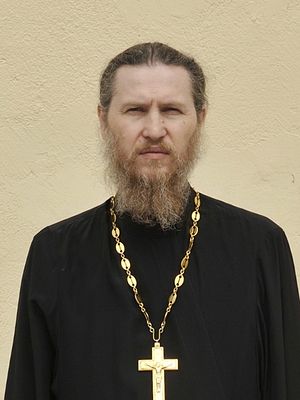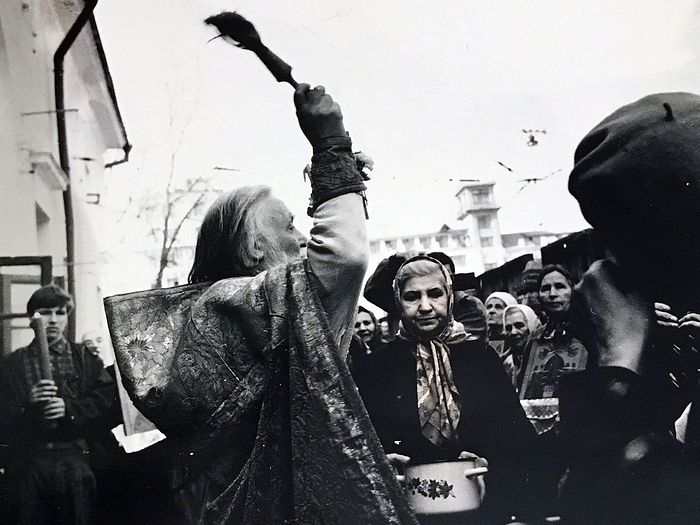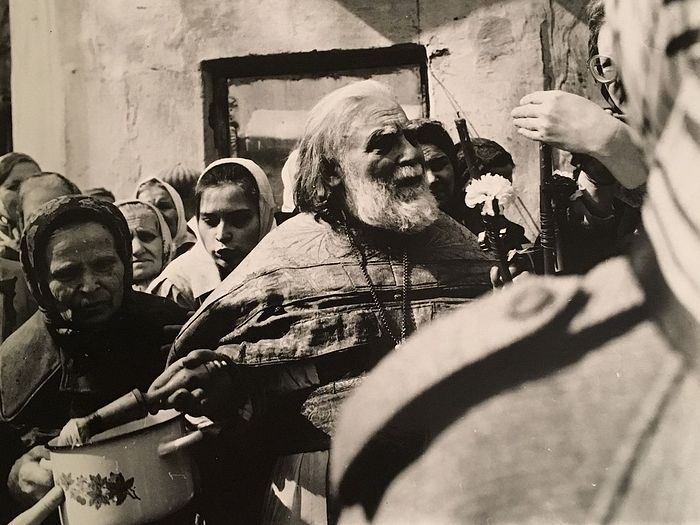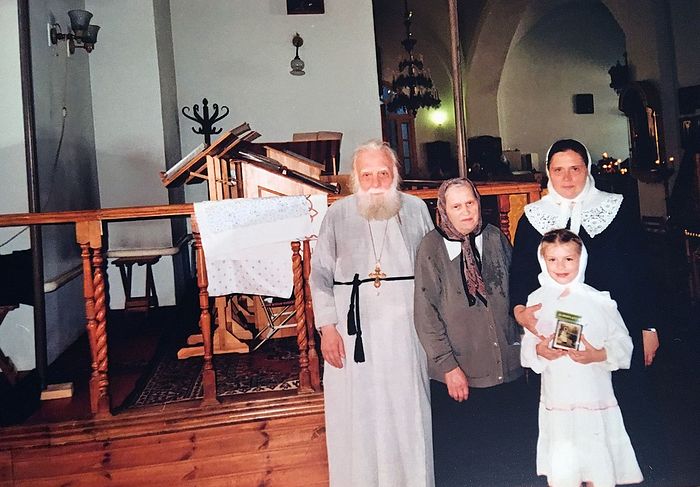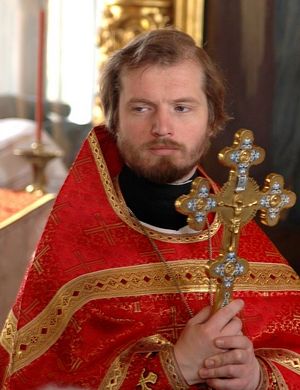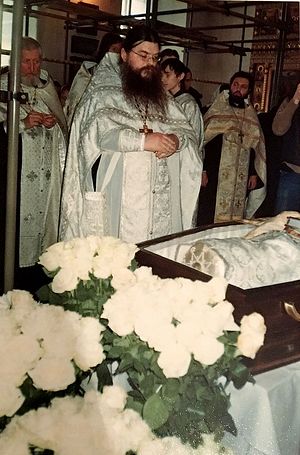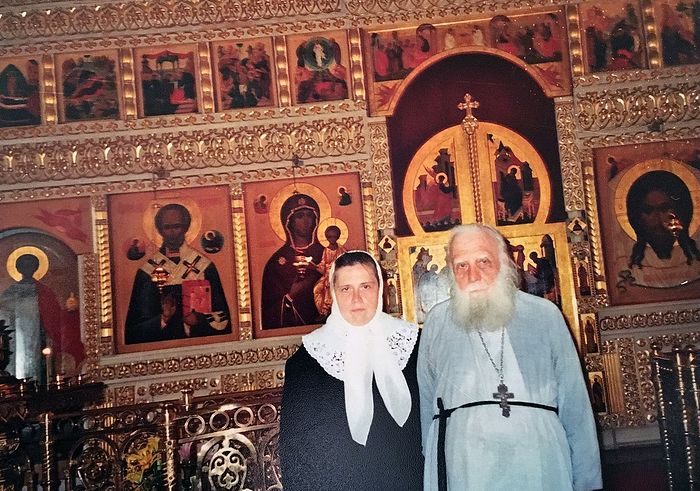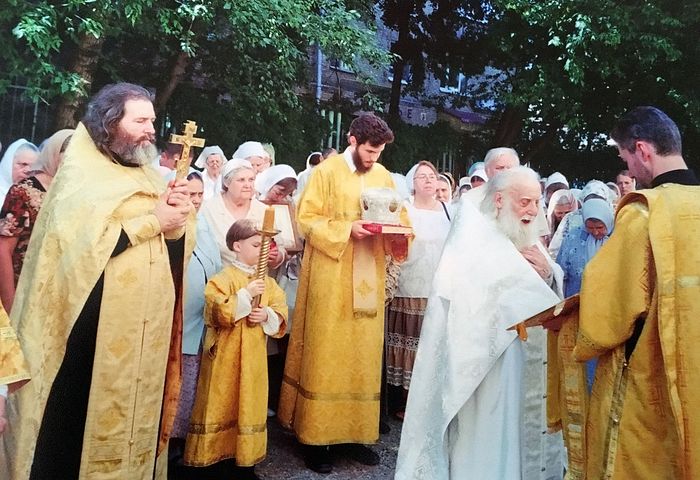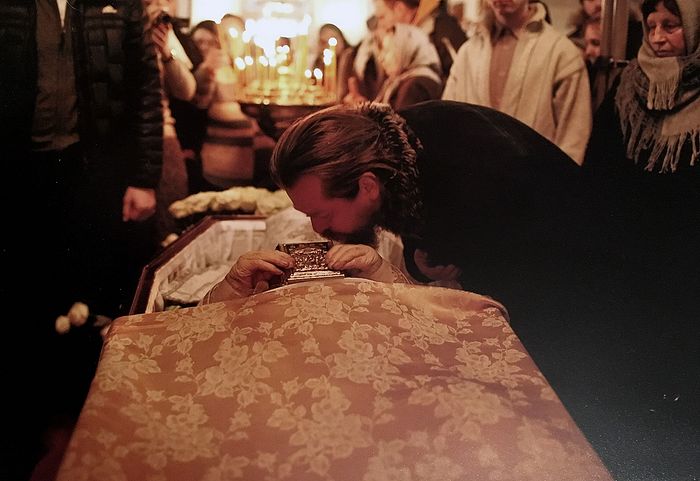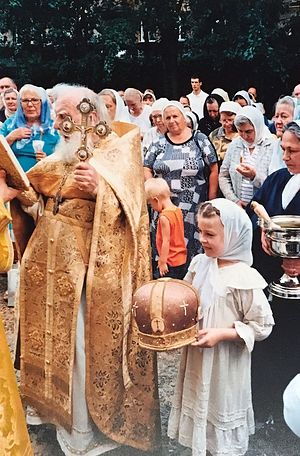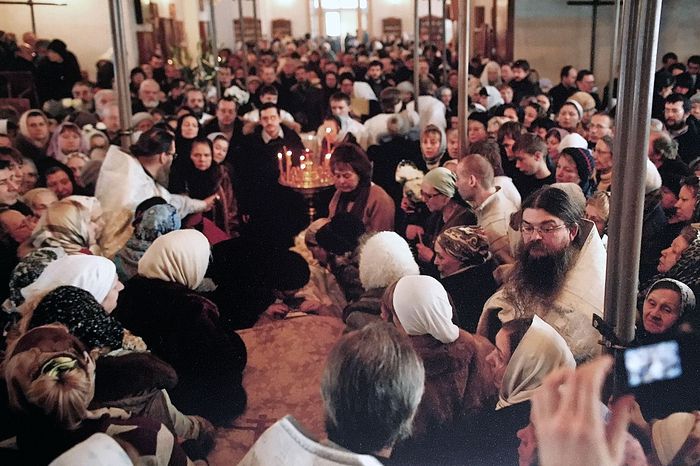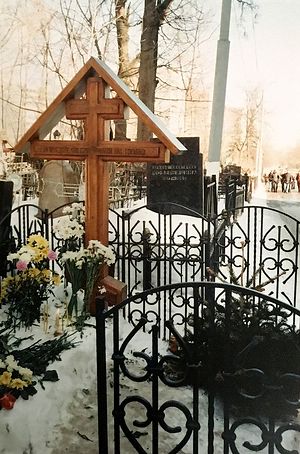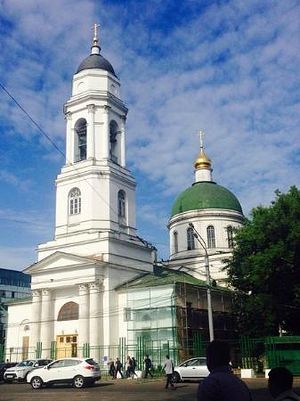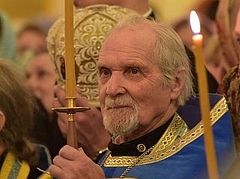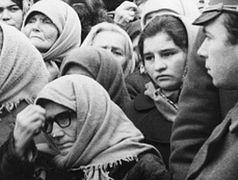Few of us can imagine what it was like during the transition period from soviet times into our own times in Russia to begin the herculean task of restoring the desecrated churches. These reminiscences paint a fragment of this picture in describing the life of one true man of God in Moscow, Archpriest Alexei Zotov.
On the sixth anniversary of the repose of Archpriest Alexei Zotov, rector of the Church of Sts. Florus and Laurus in Zatsepa [officially: Zatsepskaya Square, a small square in Dubininskaya Street], fellow-clergy, spiritual children and colleagues who restored this holy church together with him shared their memories of this loving simple-hearted elder.
A priest for whom church services never stopped
Archpriest Nicholas Krechetov, rector of the Church of the Transfiguration of the Savior in Bolvanovka, head of the Moskvoretsky Deanery:
Fr. Vsevolod Shpiller (1902-1984), then rector of the Church of St. Nicholas the Wonderworker in Kuznetsy, used to say to one of the priests of his parish, “Fr. Alexei, you don’t need to read the entrance prayers [the prayers recited by the Orthodox deacon and priest upon entering the church building before celebrating the Divine Liturgy] because you never leave the church!”
And these words characterize him best. He was a priest for whom church services never stopped.
The gift of priestly grace
Archpriest Constantine Strievsky, a cleric of the Church of St. Nicholas the Wonderworker in Kuznetsy:
I first came to the Church of St. Nicholas in Kuznetsy as a young man; I had only been baptized. So I began to work as a church guard. Once I was asked to bring something to the altar during the service. It was urgent so I hastened to the church and opened one of the Deacons’ Doors slightly. I saw Fr. Alexei inside and immediately felt something special but didn’t know how to call it at that time. “I feel so good here with him!” I thought then. Subsequently, after my ordination as a priest, I experienced a clear and evident presence of the grace of God in the altar on many occasions, but Fr. Alexei was the first to “share” it with me.
When Fr. Alexei still served in the Church of St. Nicholas in Kuznetsy, I could listen to his sermons. As compared with other priests of that church who by their eloquent speeches gathered crowds of the most progressive young people of the time around them, Fr. Alexei’s words were very simple. I could not even hear all that he said because batiushka sometimes spoke a little indistinctly. Yet his sermons always were very heartfelt and warm. People were drawn to him, and I still cherish the image of a pastor with his numerous, trusting flock gathering closely around him. The love with which he addressed and treated his parishioners was abundant! Batiushka was no longer young and, therefore, surrounded mostly by the parishioners of St. Nicholas Church of the older generation. His love remained in my heart. He was a very warm-hearted man.
One day, many years later when I served as a priest and taught at a Sunday school, I was showing slides to children. (At that time it was difficult to get them, so a set of slides that had been prepared by the Moscow Patriarchate for the millennium of the Baptism of Russia really helped me. It was an anniversary for which the Church was allowed to do the things that had been forbidden before). So I was projecting an image on to the screen. Suddenly I saw a priest by the altar and stopped… It was Fr. Alexei in the sanctuary of our St. Nicholas Church in Kuznetsy! That inexpressible touch of grace (which calls for the priesthood) ran through me once again!
Soon Fr. Alexei began to serve at the Church of Sts. Florus and Laurus. Every time we met with him it seemed as if he was immediately transformed, focused all his attention on me and welcomed me with great delight. The joy of communication with him lives on in my memory.
The Lord revealed people’s destinies to him
Natalia Viktorovna Kotelnikova, churchwarden of the Church of Sts. Florus and Laurus:
I met Fr. Alexei at the Church of St. Nicholas in Kuznetsy. I came to work there in 1985. When the preparations for the celebration of the millennium of the Baptism of Russia began, I was elected the churchwarden’s assistant. I recall that when we were sitting at the meal in the refectory Fr. Alexei would say:
“The church is suffering! The church is suffering!”
“Batiushka, who is suffering? Where is it happening?”
“The church is suffering! Machines are roaring, ‘boom-boom’!”
And I couldn’t figure out what he was talking about.
Though it was easier for Fr. Alexei to travel to the St. Nicholas Church from the Novokuznetskaya metro station, he tried to avoid this station because its entrance hall, surrounded by a public garden with a fountain, stands on the site of the destroyed Church of the Martyr Parasceva. Batiushka used to show his daughters traces of St. Parasceva’s well—if you alight at this station from the last carriage moving from the city center, you may see water at times trickling on the ceiling between the nearest columns…
Fr. Alexei, even when he still served at St. Nicholas Church in Kuznetsy, would always go past this station and alight at the next, Paveletskaya station. At that time I would actually travel directly to the St. Nicholas Church from the same station, but from the other exit (at its opposite side). It turned out that Fr. Alexei chose another exit and then would turn to the opposite side, each time walking up to the former Church of Sts. Florus and Laurus which had once adorned the neighborhood. He would walk around it and pray as if it were a cross procession. But what he heard there was not the silence of contemplation but the noise of machines… That is why he would sigh with sadness and say, “The church is suffering…”
Then people even did not recognize a church in this once magnificent building, but mutilated under the atheist regime, with a fallen dome, which had been converted into a stamp and engraving factory with roaring machines. “It is either a planetarium or a theater, we are not sure,” people would walk or drive past it hurriedly and say, puzzled at the sight of it.
But Fr. Alexei well knew what kind of a church it was and who its patrons were.
The fact is that on the feast of the Nativity of the Holy Prophet and Forerunner John the Baptist, 1960, Fr. Alexei was ordained a deacon at the Church of Sts. Florus and Laurus in Kashira [a little, picturesque, and very ancient town some seventy miles south of Moscow] by Metropolitan Nicholas (Yarushevich) of Krutitsy and Kolomna. And later, on the feast of the Holy Apostles Peter and Paul, the same hierarch ordained him a priest and assigned him to the same parish. However, Batiushka couldn’t remain there for family reasons.
On returning to Moscow Fr. Alexei went to the residence of Patriarch Alexei I, but the latter responded to his request for assignment to the patriarchal cathedral, “How can I assign you to my church? You will be the twentieth cleric in the parish!”
Fr. Alexei prayed for his new assignment before the icon of the Holy Martyr Tryphon at the Church of the icon of the Mother of God of the “Sign” near the Riga Railway Station, Moscow. Soon he joined the clergy of the Church of the Holy Prophet Elijah in Obydensky Lane because one of its priests was sick. When the latter recovered eight months later, Fr. Alexei was transferred to the Church of St. Pimen the Great near the Novoslobodskaya metro station. It housed a wonderworking icon of the Mother of God “Joy of All Who Sorrow”. Fr. Boris Pisarev, then rector of St. Pimen’s, recalled that this icon had originally been kept at the Church of Sts. Florus and Laurus where he had served as a choir director from 1931 till 1934. Afterwards, having served at St. Pimen’s Church for sixteen years and at the St. Nicholas Church in Kuznetsy for some years, Fr. Alexei (remembering that he had been ordained at the Church of Sts. Florus and Laurus in Kashira where he was not able to stay) took on the labor for restoring the church in honor of the same holy martyrs near the Paveletsky railway station [that is, the church in Zatsepskaya Square, his main church], and he took the above-mentioned miracle-working icon with him. So the icon returned to its home, where the main altar (of the central aisle) is dedicated to it. By the way, it was here, at the church’s central aisle, that the funeral service was performed over Fr. Alexei.
But the beginning of the process of the church’s restoration was preceded by the following occurrence.
It happened in 1987, three years before the Church of the Holy Martyrs Florus and Laurus in Zatsepa was transferred to the Russian Orthodox Church.
The clergy and representatives of the parish of the St. Nicholas Church in Kuznetsy were invited to the Executive Committee of the Moskvoretsky District, whose chairman, Vladimir Petrovich Novokshchenov, said to us, “Let’s prepare for the 1000th anniversary of the Baptism of Russia! We will ‘make a creditable showing’!” At that time churches were in an appalling condition, but the authorities suddenly remembered that foreign delegations might come “out of the blue” at any moment… But the faithful still did not risk attempting to ask for any improvements to the situation of the existing churches. All of a sudden Fr. Alexei stood up and, fiddling with his priestly cap, said, “Vladimir Petrovich, you have only one functioning church in the whole Zamoskvorechye district! Are you going to open more churches?”
For Fr. Alexei, who had prayed much near the desecrated Church of Sts. Florus and Laurus, this question was a matter of much suffering. Maybe he was not a good diplomat, but he spoke to the point and from the heart.
There was a long pause before anybody could speak. At that time it was unclear what consequences words like these could have: shortly before priests had been exiled, executed by shooting, required to make signed statements, oppressed by high taxes, and deprived of their registrations without which they were unable to serve. That put Fr. Vladimir Rozhkov, the then rector of the Church of St. Nicholas in Kuznetsy, off balance. “Stop, father! Sit down!” he said, tugging at Fr. Alexei’s cassock (which he never took off).
“Natalia, do you intend to open churches?! Let us start doing it!” Fr. Alexei proceeded (lest the pause drag on), addressing me so naturally. I humbly agreed and expressed my willingness “to open churches,” although none of us had ever heard this phrase before, while today it sounds so familiar to us. So, frankly speaking, I did not fully understand what exactly I ought to open: a door, a window?...
In this sense batiushka became our pioneer of the “new Church vocabulary” by suggesting “to open a new church”!
Everybody felt the presence of God near Fr. Alexei. The work on the restoration of relics and the rebirth of human souls was very intensive.
We had no idea when Fr. Alexei found any time to sleep; after the Church of Sts. Florus and Laurus was opened many old ladies started bringing Fr. Alexei intercession lists with the names of their nearest and dearest to pray for. The pastor would work on the repair and restoration of the church during the day and would read the Psalter for the souls of all those people at night. In the morning we would often see him with puffy eyes—he either did not sleep enough or prayed fervently for people with tears, perhaps both.
Fr. Alexei was a true unmercenary who always refused to accept any money or gifts that people offered him. Whenever people brought him anything, he would say, “Oh thank you! I have held it in my hand a little, so now take it back!” As soon as somebody gave him flowers, he would answer immediately, “Oh thank you! This is for the Mother of God!” and would instantly carry them to the wonder-working icon. He did not leave anything for himself and lived very modestly.
Batiushka did not allow there to be any fanfare around him. I personally remember that once, when Fr. Alexei still served at St. Nicholas Church, one lady ran up to him and asked:
“Fr. Alexei, when is the next time you will be hearing confessions?”
“Our priests hear confessions every day here, matushka. 1
“And what about you yourself, Fr. Alexei? I want to confess to you.”
“Matushka, you can go to confession here every single day.”
Fr. Alexei observed very austere rules and was above all strict with himself. He was a true ascetic in his life and discouraged any attention to his person.
Many things that Fr. Alexei clearly understood were revealed to us only many years afterwards. We remember pestering him with these questions:
“Batiushka, please, marry this couple in church. They have been helping our parish so much!...”
“No, I won’t marry them!”
“Why, batiushka?!”
“They won’t live together anyway! I cannot marry them!”
The Lord revealed people’s destinies to him. Some ten years after that conversation their marriage broke up… Fr. Alexei foresaw it from the very beginning. Once a pair of sweethearts came to him and asked for his blessing (one of many similar stories), but he led each of them aside and blessed them separately from each other. Several months later it emerged that the would-be fiancé was a heavy drinker, and the girl’s family was happy that their wedding did not take place!
This year, Metropolitan Arseny (Epifanov) of Istra served at our church on the anniversary of Fr. Alexei’s death. He also celebrated here last November (the patronal feast of the icon “Joy of All Who Sorrow”), looked at the wall paintings (which had been completed everywhere except the church porch by then) and said, “As soon as batiushka’s church-painting project is completed, we will perform a memorial service for his repose.”
Memory eternal!
A man of prayer
Archpriest Alexei Emelyanov, rector of the Church of the Iveron icon of Holy Theotokos in Bolshaya Polyanka:
I recall how as a seminary student I met Fr. Alexei at the Holy Trinity-St. Sergius Lavra. He would spend his rare free minutes there at the Holy Trinity Church, by the relics of the Venerable Sergius of Radonezh.
Everybody remembers Fr. Alexei as a very zealous pastor. He knew perfectly well the time and practice of all things performed in church. These down-to-earth instructions made the long process of integration into church life much easier for newcomers.
Batiushka deeply impressed many by his closeness to people. As a bearer of church life tradition (which was in high demand after the decades of state atheism) Fr. Alexei literally spent days and nights at the church, welcoming converts at the time when people in the country began massively returning to Christ.
Upon my ordination I served for some time at the Church of Sts. Florus and Laurus together with him. Then the church was still nearly in ruins. Batiushka made tremendous efforts to restore it. A strong and zealous community gathered around him and shared the same spirit with him.
Fr. Alexei was a man of prayer. And this is the most important thing for every priest, for the priest is by virtue of his vocation the head of each prayer congregation.
How Fr. Alexei still helps today
Elena Alexeevna Zotova, choir director of the Church of Sts. Florus and Laurus in Zatsepa, Fr. Alexei’s elder daughter:
I recall how in 1991 we came with Fr. Alexei to the Church of the Holy Martyrs Florus and Laurus to serve the sacrament of Baptism for the first time. Father was walking ahead of me and I was following him. It was still a factory at the time, with a guarded territory and big dogs running all around it. But despite everything batiushka moved forward towards the temple, holding a white canister with holy water in his hands. A guard stopped him:
“Where are you going?”
“I am heading for the house of God!”
By that time he had already been appointed the rector. He walked past the guard under the latter’s unwavering gaze and carefully sprinkled the space with the holy water.
The factory was still there. The factory manager did not want to give it up and move, saying pointblank, “Only over my dead body!” And he died suddenly soon after that.
There was a fierce struggle with the factory. Though services resumed, the machines continued to roar beyond the wall. There was a metalwork factory there, they produced rulers, but piles of things were just left around haphazardly.
Initially the church could be entered through the left side left side-altar; a window was removed there to make space for a door. It was there that the first services were held and the church began to return to life.
Despite the multitude of cares that fell upon the rector’s shoulders during the church’s restoration, Fr. Alexei tried not to shorten church services. Those days in Moscow you could find very few parish churches where the troparia appointed to be sung during the Beatitudes at the Liturgy were chanted. I think there were only two parishes that observed this tradition: Fr. Alexei’s parish of Sts. Florus and Laurus and the Church of St. Nicholas in Klenniki in Maroseika Street, where the rector was Fr. Alexander Kulikov.
It should be noted that father always read the prayers of the midnight service at home. If he was sick and accidentally overslept, he was distressed over it and said, “I am crazy! I overslept!”
He would always read all the services of the daily liturgical cycle (introduced by the Monastery of St. Zosima and the Smolensk icon of the Mother of God in the Vladimir region where his confessor, Igumen Platon (Klimov), lived in the village of Petushki), even on the days when he did not serve at church.
Batiushka’s prayers helped us very much in his lifetime and we still feel their power today. A month ago one bishop came to us and said, “Do you happen to know where the burial site is of Schema-Archimandrite Daniel (Klimkov), popularly known as Archimandrite Seraphim?”
On the internet one can find the information that he is buried at Kotlyakovskoye Cemetery, but this cemetery has as many as eighty sections! It was unclear where we were supposed to look for his grave, and nobody could give us this information. Thus we searched for a whole month, but with no result.
“Fr. Alexei is our last hope!” we said and went to pray at his grave.
Earlier, whenever we couldn’t find the grave of one or another cleric, we turned to Fr. Alexei in prayers, and all the difficult problems were solved.
This time too we came with a nun to father’s grave.
“Fr. Alexei, please, help us! We cannot find the resting place of this archimandrite…”
This is how events developed next. On February 2 of this year (2018), Fr. John Slugin, acting rector of the St. Nicholas Church “Podkopai”, reposed. His funeral was served at the Church of the Descent of the Holy Spirit upon the Apostles at Danilovskoye Cemetery. Fr. Alexei had been buried at the same cemetery. Thus, a woman in her sixties came up to me. She was dressed simply but her clothes were secular. But my inner voice said to me, “Ask her!”
“Do you happen to know where is the grave of Schema-Archimandrite Daniel (Klimkov), popularly known as Archimandrite Seraphim?”
“I don’t know exactly, but I can certainly tell you the section.”
Thus, we finally found the right grave through my father’s prayers!
Why I was drawn to this church…
Archpriest Alexander Tikhonov, rector of the Church of the Holy Prophet Elias in Vorontsovo Field, Fr. Alexei’s son-in-law:
Once in the early 1980s, when Fr. Alexei served at the Church of St. Nicholas in Kuznetsy, this church decided to carry out repairs and asked for advice from St. Daniel’s Monastery (where I then labored) concerning the belfry. At one time the staff workers of the prosecutor’s office that had once occupied the building of what is now St. Tikhon’s Orthodox University of the Humanities demanded that the belfry arches facing it with plywood be blocked off. A structure had been knocked together around the belfry but now it was dismantled ahead of the celebration of the millennium of the Baptism of Russia, and bells needed to be set and tuned. While I was tinkering with the bells and rehanging them, I needed a pair of pliers. Someone brought them to me, but I had to take them back myself. I knocked at the door, it opened, and Fr. Alexei came out with a sunny, radiant smile, as if he had been waiting for me all his life! And I handed him the pliers…
After that my acquaintances who were parishioners of St. Nicholas Church in Kuznetsy invited me there for a service. Thereupon I tried to catch Fr. Alexei’s sight every time.
Soon I went on a business trip with my parents for two years. Upon my return in 1989 I became a seminary student, and soon learned that the Church of Sts. Florus and Laurus in Zatsepa had been opened! I had always been drawn to this church. On two occasions I even managed to slip past that down-and-out foul-mouthed man who kept watch there and who jumped on nearly anyone, “Where are you going? Get out!”
One day I somehow contrived to move as far as the altar. “How did you get here? Who let you in?!” the workers who were taking a break stared at me… They “hit the ceiling” and chucked me out forthright. Now I recall this story as a nightmare.
Now my daughter Liza [a diminutive form of the name Elizabeth/Elizaveta in Russian] dreams that she is standing in the church, when two altar boys (her brothers Alexei and Dmitry, the latter of whom is now a hieromonk) come out of the altar wearing yellow stoles and her grandfather, Fr. Alexei, suddenly descends from above in golden vestments and a miter… But people of my generation saw absolutely different dreams with very different characters in them…
Perhaps I felt an urge to attend this very church due to “genetic memory,” since my ancestors lived in the same neighborhood. My paternal grandmother used to say that it was “the Church of Lavra-Flora” (this is how common folk called it under the tsar—as a tongue twister). Therefore, as soon as the church was opened, I went there with great haste. I asked while running:
“Who serves here?”
“Fr. Alexei Zotov!”
“Oh, I know him!”
So I came running there and saw that the gate was wide open, while it had always been closed before. I found the door on the left-hand side and entered. The left altar had already been cleared, and there were sand-filled basins with candles in them. The altar screen was made of bricks with curtains thrown over it. The floor tiles were cheap, like in public restrooms. Looking closely around, I spotted paper icons on the bare walls. But most importantly I felt an incomparable peace.
I was drawn to this church permanently from that time on. At the time I was a subdeacon of Metropolitan Juvenaly (Poyarkov) of Krutitsy and Kolomna. So I would assist Metropolitan Juvenaly early in the morning at Novodevichy Convent, then would swiftly run towards the Church of Sts. Florus and Laurus (dropping in at Donskoy Monastery and St. Daniel’s Monastery on my way just to venerate main relics there).
Fr. Alexei and I set about clearing the debris in the church with vigor. I was young, while batiushka was over sixty. I clearly remember seeing Fr. Alexei walking with an elderly woman of the same age and carrying an extremely heavy log. He even could break slabs himself. Indeed they had so much strength and fortitude, these representatives of the dying and disappearing pre-war generation. I would go to the Lavra for a week to continue my studies at the seminary and on my return for the weekend I was amazed every time at the great amount of work that Fr. Alexei had managed to do in my absence!
I recall how together with Fr. Alexei we would carefully break and clear all that stuff. There were intermediate floors everywhere with partitions dividing the now cleared huge church space into tiny rooms. We dismantled all of them gradually. During that period Fr. Alexei literally lived in the church, only going back home once a week to change his clothes and then getting back to work. We couldn’t celebrate services every day at that stage because we were breaking walls and the air was full of dust.
On top of that, the church was poisoned; wastes from the galvanizing plant—alkali and acids—had been poured into the air duct under the floor. One day as we were rummaging in the debris we prodded down and discovered a vault, prodded again and saw an air duct. It appeared that it had turned green as it was filled with vitriol. I remember standing in the bottom of that pit and shoveling up this compacted waste. So I had to remove about ten feet of the refuse. Old ladies would labor there throughout the day and carry out these piles of rubbish with their own hands. Then they would carefully sweep and wash the floor.
Afterwards we cleared the attic together, and it was a real nightmare! When in the 1950s the sacrilegious workers smashed the belfry, they simply threw the rubble into the attic. It remains a mystery why the ceiling had not collapsed on the factory workers in those years. Moreover, they had set up a dining hall in the space under the dome. Over the Soviet period they would throw broken crockery into the attic as well. It seems that these “Red” raiders realized that they were temporary owners of this building. All in all we lowered innumerable sacks of this trash from the attic.
Fr. Alexei was a very loving pastor and a true man of prayer. On graduating from the seminary I labored in his church as an acolyte, a bell-ringer, a choir member… And it was here that I met my future wife, batiushka’s younger daughter Olga. We got married with the blessing of Fr. Alexei and became one family with him; but this is absolutely another story…
“The fatherly embrace”2
Olga Tikhonova (Zotova), choir director of the Church of the Holy Martyrs Florus and Laurus, Fr. Alexei’s younger daughter:
I have written a book on my father which is yet to be published. Now I will only tell the readers how he came to serve at the Church of Sts. Florus and Laurus and passed away, leaving us orphans.
“Your Eminence, I honestly don’t feel guilty for anything special in life except for being not completely faithful to the saints to whose church I was assigned at the beginning of my ministry,” Fr. Alexei said to Bishop Arseny (Epifanov)—who then was very young—thirty years after leaving the Church of Sts. Florus and Laurus in Kashira.
With the blessing of Patriarch Alexei II, my father at the age of sixty was appointed rector of a church dedicated to the saints to whom he felt indebted.
And he worked here unceasingly from morning to evening, without any rest.
If father sometimes went on leave, he would spend this time as a simple monastery laborer in the Holy Trinity-St. Sergius Lavra. He much appreciated being allowed to read the Akathist beside the relics of St. Sergius. When he had rare days off, he always tried to spend them at the Lavra. And he did it “on an empty stomach” every time. Likewise, he would not eat anything before going to perform special services of need (treby) like giving Communion to the sick or the dying, on those days. Whenever anybody asked him to go and give Communion to a sick or dying person at the latter’s home, Fr. Alexei would immediately stop his work and hasten to administer the last rites to the one in need. If he was scheduled to arrive by four or five in the afternoon, Fr. Alexei would not eat or drink anything on that day before then.
One of the most distressing things for a priest is not being in time to administer the last rites to a dying person.
Shortly before his repose, father told me, “When I die, you won’t have to blush for me as I am not guilty before anybody in this life.” Another time he assured me that I shouldn’t worry after his death because he had read everything for himself, implying the Gospels read over a dead priest’s coffin.
After the church had been fully restored, while reading the words of Christ addressed to the repentant Peter during the cross procession around the church on the feast-day of the Apostles Peter and Paul [to whom the right side-altar of the church is dedicated.—Trans.] at the fiftieth anniversary of his ordination as a priest, When thou wast young, thou girdest thyself, and walkedst whither thou wouldest: but when thou shalt be old, thou shalt stretch forth thy hands, and another shall gird thee, and carry thee whither thou wouldest not (Jn. 21:18), father put his hand on his chest, as if showing that these words applied to him as well.
He sought to spend his life in monasticism. By the way, when he was very young, St. Kuksha of Odessa (1875-1964) gave him a blessing for monastic life… But when Fr. Alexei returned to his spiritual father, Fr. Platon (Klimkin), who had gone through prisons and labor camps, the latter unexpectedly told him that churches would be opened in Russia in large numbers and parish priests would be needed to guide people living in the world in spiritual life. So he gave Fr. Alexei a blessing for marriage…
When their first daughter Elena was born, my parents decided to fulfil their dream and live “as brother and sister”. But their confessor, Fr. Platon, gave them a blessing for another child. Thus I, Olga, was born. And from that point on they abstained from marital relations for the rest of their lives.
It should be stressed that despite his ascetic disposition, Fr. Alexei loved children dearly and really doted on his grandchildren. He could allow his granddaughter to hold his miter during the Gospel reading at the cross procession or say a few endearing words to his grandson, an acolyte. “My darling! Such a nice boy! You are growing and already come out with a candle…”
The abundant love and kindness that Fr. Alexei generously poured out not only on his family but also on every single person, “opening his fatherly embrace”, were in harmony with his deep concentration on prayer. In giving him a blessing for marriage, Fr. Platon also gave him a lengthy monastic prayer rule to observe, which Fr. Alexei most carefully did throughout his life, waking up at four or half past four in the morning every single day.
When father had a chance to talk with Bishop Tihon (Shevkunov) in more recent times, he sometimes remarked, “I baptized you and now, please, you tonsure me!”
During his meetings with Metropolitan Arseny of Istra either at our church (where the hierarch is a frequent guest) or at his residence, Fr. Alexei would again and again start conversations about monastic life…
After batiushka’s repose, in his funeral speech Metropolitan Arseny noted that Fr. Alexei had providentially departed to the Lord on the Sunday of the Prodigal Son—the only day in the yearly cycle when the Church sings the hymn beginning with, “Open Thy Fatherly Embrace”, which is also sung in the service of the monastic tonsure.
“Thus has the Lord shown that He approved the desire of his (Fr. Alexei’s) heart,” the hierarch concluded.
“I want more fish”
Alexei Tikhonov, Archpriest Alexei Zotov’s grandson:
My father and I intended to go to the town of Pechory. Before our departure we decided to visit Danilov Cemetery and visit the grave of my grandfather, Fr. Alexei Zotov, on our way. I dropped in at the church, while my mom was reading the kathisma from the Psalter. Next I came up to the grave, and mother told me, “Put your hands together, palms up, as if you were asking for a blessing, and ask for what you need.” At that moment I was very hungry. So I stood and asked, “Grandpa, please pray that my dad and I will have more fish on our journey.” And it turned out that my father took fish for our journey!
***
This large, spacious, magnificent and at the same time modest, tall white church in the imperial style, with a wooden floor and very cozy atmosphere inside stands just one minute walk from the Paveletskaya metro station not far from the railway station with the same name in central Moscow.
Its patrons, the holy brothers Florus and Laurus, were martyred for Christ in the Balkans in the second century. They were greatly venerated by Russian people in old times and regarded as the heavenly patrons of horses (local coachmen would lead their horses in front of the church with a special blessing service performed for them on their feast-day in the past). Their veneration increased after the Russian victory at Kulikovo Field, as it is known that St. Sergius blessed Prince Dmitry Donskoy before the battle with Mamai exactly on the feast-day of Sts. Florus and Laurus, August 18/31. From that time on they were regarded as being among the heavenly protectors of Russia, and a special icon, “The Miracle of Archangel Michael and the Martyrs Florus and Laurus,” was specially painted.
The first wooden church on this site was first mentioned in 1625, though it had existed earlier. In that century the local area was the customs border of Moscow and the territory was called “the Yam [mail stage post] Sloboda [settlement] of Kolomna”. The church stood on an important road leading to Kashira, which was one of major strongholds on the southern border areas of the Principality of Moscow. Three churches in honor of Sts. Florus and Laurus were thus built on the same line heading south: here, in the village of Old Yam, in the Domodedovo district, and in Kashira. The original church was destroyed by fire and a replacement stone church was constructed by 1745. By the beginning of the nineteenth century, apart from coachmen representatives of the nobility, the military, merchants, middle-class citizens and peasants began to settle in this neighborhood in large numbers, and the area was nearly built up. With the blessing of St. Philaret of Moscow the church was rebuilt between 1833 and 1839 and considerably enlarged by 1861. From 1892 on, its Sunday school provided primary education to the whole of the huge neighborhood of Zamoskvorechye. Before the Revolution the temple was beautified, and from 1924 many relics and church vessels were transferred here from desecrated Moscow churches, including the Cathedral of Christ the Savior, which was demolished. The services at this church stopped in 1938 and resumed in 1991. It is officially called “The Church of the icon of Holy Theotokos “Joy of All Who Sorrow””, but it is popularly known as “the Church of Sts. Florus and Laurus”, as it was centuries ago. The temple has its own new martyrs: Archpriest Nicholas Vinogradov, who was its rector from 1929 and who after years of labor camps was executed by a firing squad at the Butovo Firing Range (1876–1937; Master of Theology, author of several written works; feast: November 14/27), and Priest Dimitry Rozanov, who served here for some years and was executed at Butovo (1890–1937; feast: November 12/25). (Information taken for this reference from the church’s official website: http://hram-flora-lavra.ru/index.php).



